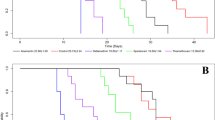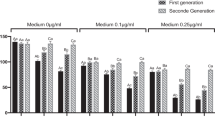Abstract
Various organisms are adversely affected when subjected to chronic fluoride exposure. This highly electronegative ion present in several insecticide formulations is found to be lethal to target pests. In the present study, Drosophila melanogaster is treated with sub-lethal concentrations of a diamide insecticide formulation, Flubendiamide. Chronic exposure to the diamide (0.5–100 μg/mL) was found to be responsible for increase in fluoride ion concentration in larval as well as adult body fluid. Interestingly, 100 μg/mL Flubendiamide exposure resulted in 107 and 298% increase in fluoride ion concentration whereas only 23 and 52% of Flubendiamide concentration increase in larval and adult body fluid, respectively. Further, in this study, selected life cycle parameters like larval duration, pupal duration and emergence time showed minimal changes, whereas percentage of emergence and fecundity revealed significant treatment-associated variation. It can be noted that nearly 79% reduction in fecundity was observed with 100 μg/mL Flubendiamide exposure. The variations in these parameters indicate probable involvement of fluoride ion in detectable alterations in the biology of the non-target model insect, D. melanogaster. Furthermore, the outcomes of life cycle study suggest change in resource allocation pattern in the treated flies. The altered resource allocation might have been sufficient to resist changes in selective life cycle parameters, but it could not defend the changes in fecundity. The significant alterations indicate a definite trade-off pattern, where the treated individuals happen to compromise. Thus, survival is apparently taking an upper hand in comparison to reproductive ability in response to Flubendiamide exposure.

The figure demonstrates increase in Fluoride and Flubendiamide concentrations in Drosophila melanogaster after chronic sub-lethal exposure to Flubendiamide. Treatment-induced alterations in larval and pupal duration, reduction in fecundity and alteration in male-female ratio is also observed.









Similar content being viewed by others
References
Aguila, J. R., Suszko, J., Gibbs, A. G., & Hoshizaki, D. K. (2007). The role of larval fat cells in adult Drosophila melanogaster. Journal of Experimental Biology, 210, 956–963.
Arnot, J. A., & Gobas, F. A. P. C. (2006). A review of bioconcentration factor (BCF) and bioaccumulation factor (BAF) assessments for organic chemicals in aquatic organisms. Environmental Reviews, 14, 257–297. https://doi.org/10.1139/A06-005.
Australian Pesticides and Veterinary Medicines Authority (2009). Public release summary on “Evaluation of the new active Flubendiamide in the product/s Belt 480 SC insecticide & Belt 240 WG insecticide”, Canberra.
Basic methods of culturing Drosophila, updated 30/3/2007, Bloomington Drosophila Stock Center, Indiana University.
Benford, D. J., Hanley, A. B., Bottrill, K., Oehlschlager, S., Ball, M., Branca, F., Castegnaro, J. J., Descotes, J., Hemminiki, K., Lindsay, D., & Schilter, B. (2000). Biomarkers as predictive tools in toxicity testing. ATLA, 28, 119–131.
Chandrashekara, K. T., & Shakarad, M. N. (2011). Aloe vera or resveratrol supplementation in larval diet delays adult aging in the fruit fly, Drosophila melanogaster. The Journals of Gerontology. Series A, Biological Sciences and Medical Sciences. https://doi.org/10.1093/gerona/glr103.
Chen, Y. (2003a). Variable tolerance of the silkworm Bombyx mori to atmospheric fluoride pollution. Fluoride, 36, 157–162.
Chen, Y. (2003b). Differences in fluoride effects on fecundity among varieties of the silkworm Bombyx mori. Fluoride, 36(3), 163–169.
Cui, L., Rui, C., Yang, D., Wang, Z., & Yuan, H. (2017). De novo transcriptome and expression profile analyses of the Asian corn borer (Ostrinia furnacalis) reveals relevant flubendiamide response genes. BMC Genomics, 18(1), 20.
Das, S. K., Podder, S., & Roy, S. (2010). Effect of fungicide, Thiovit® Jet on several life history trait of Drosophila melanogaster (Diptera: Drosophilidae). Journal of Applied Biological Sciences, 4, 31–36.
Das, S. K., Podder, S., Akbari, S., & Roy, S. (2011). Impact of Thiovit-Jet treatment on HSP70 expression, as a stress indicator, in transgenic Drosophila melanogaster. Proceedings of the Zoological Society, 64, 17–22.
Dutta, M., Das, S., & Roy, S. (2014a). Structural alterations in compound eye of Drosophila melanogaster in response to sodium fluoride treatment. Toxicological and Environmental Chemistry, 96, 106–113.
Dutta, M., Sarkar, S., & Roy, S. (2014b). Sodium fluoride induced alteration in lifecycle parameters and compound eye morphology of Drosophila melanogaster and trans-generational transmission of the altered eye architecture. Journal of International Academic Research for Multidisciplinary, 2, 247–259.
Dutta, M., Rajak, P., Khatun, S., & Roy, S. (2017). Toxicity assessment of sodium fluoride in Drosophila melanogaster after chronic sub-lethal exposure. Chemosphere, 166, 255–266. https://doi.org/10.1016/j.chemosphere.2016.09.112.
Ebbinghaus-Kintscher, U., Luemmen, P., Lobitz, N., Schulte, T., Funke, C., Fischer, R., Masaki, T., Yasokawa, N., & Tonishi, M. (2006). Phthalic acid diamides activate ryanodine sensitive Ca2+ release channels in insect. Cell Calcium, 39, 21–33.
EFSA (European Food Safety Authority). (2010). Reasoned opinion of EFSA: modification of the existing MRLs for Flubendiamide in various food commodities. EFSA Journal, 8(12), 1960 (45). https://doi.org/10.2903/j.efsa.2010.1960.
Festing, M. F. H., Baumans, V., Combes, D. R., Halder, M., Hendricsen, F. M., & Howard, B. R. (1998). Reducing the use of laboratory animals in biomedical research: problems and possible solutions. ATLA, 26, 283–301.
Gerdes, R. A. (1971). The influence of atmospheric hydrogen fluoride on the frequency of sex-linked recessive lethals and sterility in Drosophila melanogaster. Fluoride, 4, 25–29.
Government of India, Ministry of Agriculture, Department of Agriculture & Cooperation (2009). Directorate of plant protection, quarantine & storage, central insecticide board & registration committee, N.H. iv, Faridabad-121 001, registered under the insecticides act, 1968. Accessed on April 1 2017. http://www.cibrc.nic.in/mupi.pdf.
Guo, X. Y., Sun, G. F., & Sun, Y. C. (2003). Oxidative stress from fluoride induced hepatotoxicity in rats. Fluoride, 36, 25–29.
Gutknecht, J., & Walter, A. (1981). Hydrofluoric and nitric acid transport through lipid bilayer membranes. Biochimica et Biophysica Acta, 644(1), 153–156.
Hanhijarvi, H. (1974). The effect of renal diseases on the free ionized plasma fluoride concentrations in patients from anb artificially fluoridated and non-fluoridated drinking water community. Proceedings of the Finnish Dental Society, 70, 35–43.
Huang, H., Smilowitz, Z., & Saunders, M. C. (1995). Toxicity and field efficacy of cryolite against Colorado potato beetle (Coleoptera: Chrysomelidae) larvae. Journal of Economic Entomology, 88(5), 1408–1414.
Lai, T., & Su, J. (2011). Effects of chlorantraniliprole on development and reproduction of beet armyworm, Spodoptera exigua (Hübner). Journal of Pest Science, 84, 381–386.
Mitchell, B., & Gerdes, R. A. (1973). Mutagenic effects of sodium and stannous fluoride upon Drosophila melanogaster. Fluoride, 6, 113–117.
Nadda, G., Saxena, P. N., & Srivastava, G. (2005). Effect of sublethal doses of beta-cyfluthrin on mutant Drosophila melanogaster (Diptera: Drosophilidae). Applied Entomology and Zoology, 40(2), 265–271. https://doi.org/10.1303/aez.2005.265.
Nirmalakallagadda, & Rathnamma, V. (2014). Flubendiamide a phthalic acid diamide effect on protein metabolism of freshwater fish Labeo rohita (Hamilton). International Journal of Recent Scientific Research, 5(9), 1554–1557.
Nishimatsu, T., Hirooka, T., Kodama, H., Tonishi, M., & Seo, S. (2005). Flubendiamide a new insecticide for controlling lepidopterous pests. In BCPC International Congress: Crop Science and Technology, 5764. Glasgow: British Crop Protection Council.
Podder, S., & Roy, S. (2013). Study of the changes in life cycle parameters of Drosophila melanogaster exposed to fluorinated insecticide, cryolite. Toxicology and Industrial Health. https://doi.org/10.1177/0748233713493823.
Podder, S., & Roy, S. (2014). Exposure-dependent variation in cryolite induced lethality in the non-target insect, Drosophila melanogaster. Interdisciplinary Toxicology, 7, 17–22.
Podder, S., Akbari, S., & Roy, S. (2012). Cryolite induced morphological change in the compound eye of Drosophila melanogaster. Fluoride, 45, 58–64.
Rajak, P., Sahana, S., & Roy, S. (2013). Acephate-induced shortening of developmental duration and early adult emergence in a non-target insect Drosophila melanogaster. Toxicology and Environtal Chemistry, 95, 1369–1379.
Rajak, P., Dutta, M., & Roy, S. (2014). Effect of acute exposure of acephate on hemocyte abundance in a non-target victim Drosophila melanogaster. Toxicology and Environtal Chemistry, 96(5), 768–776.
Rand, M. D. (2010). Drosophotoxicology: the growing potential for Drosophila in neurotoxicology. Neurotoxicology and Teratology, 32(1), 74.
Sarkar, S., Dutta, M., & Roy, S. (2015a). Potential toxicity of Flubendiamide in Drosophila melanogaster and associated structural alterations of its compound eye. Toxicology and Environtal Chemistry, 96, 1075–1087.
Sarkar, S., Podder, S., & Roy, S. (2015b). Flubendiamide-induced HSP70 expression in transgenic Drosophila melanogaster (hsp70-lacZ). Current Science, 108(11), 2044–2050.
Sattar, S., Farmanullah, Saljoqi, A. R., Arif, M., Sattar, H., & Qazi, J. I. (2011). Toxicity of some new insecticides against Trichogramma chilonis (Hymenoptera: Trichogrammatidae) under laboratory and extended laboratory conditions. Pakistan Journal of Zoology, 43(6), 1117–1125.
Sisodia, S., & Singh, B. N. (2012). Experimental evidence for nutrition regulated stress resistance in Drosophila ananassae. PLoS One, 7(10), e46131. https://doi.org/10.1371/journal.pone.0046131.
Stechert, C., Kolb, M., Rödel, M. O., & Bahadir, M. (2015). Effects of insecticide formulations used in cotton cultivation in West Africa on the development of flat-backed toad tadpoles (Amietophrynus maculatus). Environmental Science and Pollution Research, 22(4), 2574–2583.
Sternweis, P. C., & Gilman, A. G. (1982). Aluminium: a requirement for activation of regulatory component of adenylate cyclase by fluoride. Proceedings of the National Academy of Sciences of the United States of America, 79, 4888–4891.
Sullivan, K. M. C., Scott, K., Zuker, C. S., & Rubin, G. M. (2000). The ryanodine receptor is essential for larval development in Drosophila melanogaster. Proceedings of the National Academy of Sciences of the United States of America, 97(11), 5942–5947.
Tohnishi, M., Nakao, H., Furuya, T., Seo, A., Kodama, H., Tsubata, K., Fujioka, S., Kodama, H., Hirooka, T., & Nishimatsu, T. (2005). Flubendiamide, a novel insecticide highly active against lepidopterous insect pests. PSSJ, 30, 354–360.
Tsikolia, M., Berniera, U. R., Coya, M. R., Chalaireb, K. C., Becnela, J. J., Agramontea, N. M., Tabancac, N., Wedged, D. E., Clarka, G. G., Linthicuma, K. J., Swalee, D. R., & Bloomquiste, J. R. (2013). Insecticidal, repellent and fungicidal properties of novel trifluoromethylphenyl amides. Pesticide Biochemistry and Physiology, 107, 138–147. https://doi.org/10.1016/j.pestbp.2013.06.006.
USEPA (United States of Environmental Protection Agency) (2010). Accessed March 28, 2017 http://www.gpo.gov/fdsys/pkg/FR-2010-11-05/html/2010-27998.html.
Wanumen, A. C., Sánchez-Ramos, I., Viñuela, E., Medina, P., & Adán, Á. (2016). Impact of feeding on contaminated prey on the life parameters of Nesidiocoris tenuis (Hemiptera: Miridae) adults. Journal of Insect Science, 16(1), 103.
Wene, G., & Hansberry, R. (1944). Toxicity of cryolite to Mexican bean beetle larvae. Journal Economic Entomology, 37(5), 656–659.
Whitford, G. M., Bawden, J. W., Bowen, W. H., Brown, L. J., Ciardi, J. E., Clarkson, T. W., Imrey, P. B., Kleerekoper, M., Marthaler, T. M., McGuire, S., Ophaug, R. H., Robinson, C., Schultz, J. S., Stookey, G. K., Tochman, M. S., Venkateswarlu, P., & Zero, D. T. (1994). Report for working group I: strategies for improving the assessment of fluoride accumulation in body fluids and tissues. Advances in Dental Research, 8, 113–115.
Acknowledgements
The authors are grateful to the head, DST-FIST- and UGC DSR-sponsored Department of Zoology, The University of Burdwan, for providing the infrastructural facilities during the course of the work. We thank Dr. A Mazumdar, BU, for extending the environmental chamber facility required for the fly culture. Dr. G Aditya is also thankfully acknowledged for his kind help in statistical analysis.
Author information
Authors and Affiliations
Corresponding author
Ethics declarations
Conflict of interest
The authors declare that they have no competing interest.
Ethical approval
This article does not contain any studies with human participants or animals performed by any of the authors.
Rights and permissions
About this article
Cite this article
Sarkar, S., Roy, S. Monitoring the effects of a lepidopteran insecticide, Flubendiamide, on the biology of a non-target dipteran insect, Drosophila melanogaster . Environ Monit Assess 189, 557 (2017). https://doi.org/10.1007/s10661-017-6287-6
Received:
Accepted:
Published:
DOI: https://doi.org/10.1007/s10661-017-6287-6




